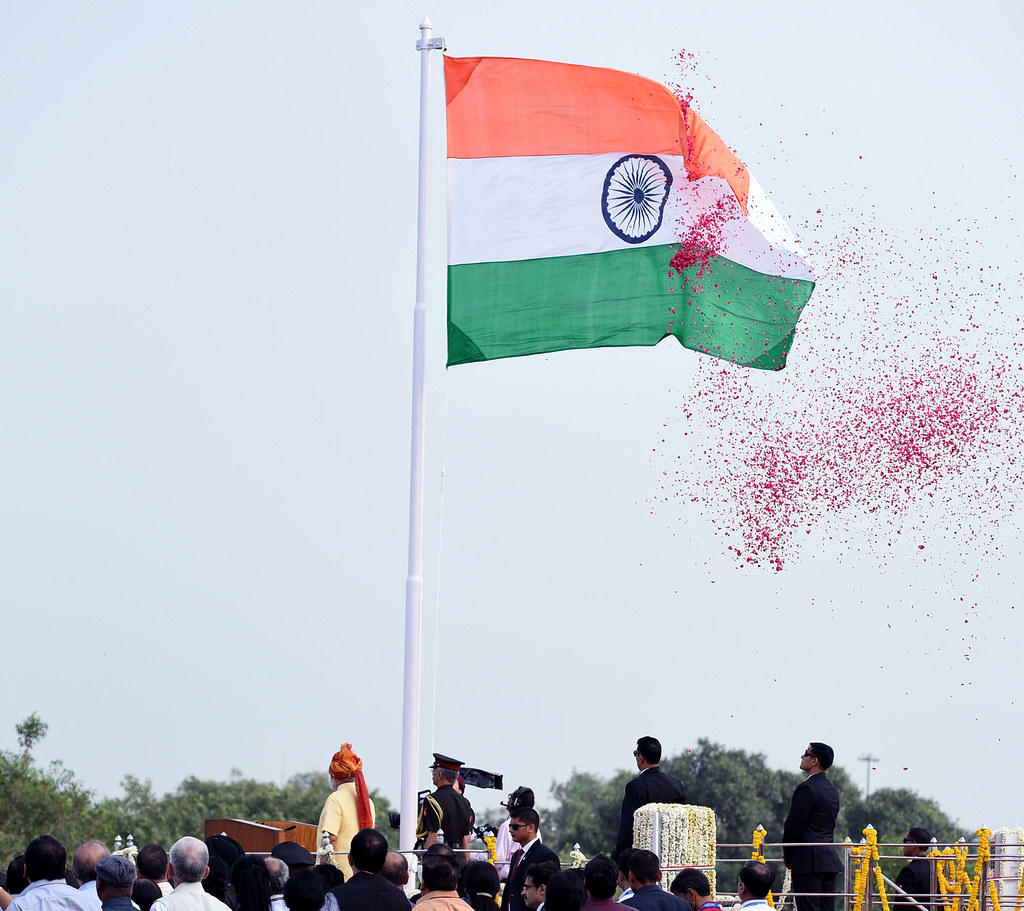Independence Day is a national holiday in India that is observed every year on August 15th. Independence Day signifies the termination of British dominion in 1947, facilitated by the Indian Independence Act of July 18th in the same year, and the formation of a sovereign and autonomous Indian state. Additionally, it commemorates the anniversary of the division of the subcontinent into two nations, India and Pakistan, which took place at midnight on August 14–15, 1947. In Pakistan, Independence Day is commemorated on the 14th of August.
Independence Day in India is celebrated with flag-raising ceremonies, military exercises, and the rendition of the Indian national hymn. Furthermore, a wide range of cultural activities are offered in the state capitals. Following the prime minister's involvement in the flag-raising ceremony at the Red Fort, a procession takes place with the armed forces and police personnel. Subsequently, the prime minister makes a televised speech to the nation, summarizing the significant achievements of India in the preceding year and delineating forthcoming challenges and objectives. Kite flying has also been customary on Independence Day, as kites of many dimensions, forms, and hues adorn the sky. In addition, government offices in New Delhi are illuminated throughout the holiday as a way to honor the day, despite being closed.

India's Journey to Freedom at Midnight
Jawaharlal Nehru's speech, which began with the words "At the stroke of the midnight hour, when the world sleeps…", signified the commencement of India's independence. At the break of day, the members of the Constituent Assembly stood up and vowed to devote themselves to the service of a fresh India. Hansa Mehta, an educator and women's rights champion from Gujarat handed the national flag of India to President Rajendra Prasad on behalf of the women of India. Freedom warrior and politician Sucheta Kriplani performed the national anthem.

India's war for independence, which resulted in the liberation of one-seventh of the global population on 15 August 1947, was a protracted and challenging endeavor that spanned many decades. It has several prominent characteristics that distinguish it significantly from liberation movements in other regions of the globe. An important factor was that it was predominantly nonviolent.
While a minority of Indian revolutionaries advocated for military conflict as the sole means of overthrowing the British, the majority of Indian independence fighters adhered to Mahatma Gandhi's ideas of nonviolent resistance in their struggle against the formidable British empire.
The momentum of the liberation struggle increased significantly upon Gandhi's return from South Africa, where his role as an activist and lawyer had a profound impact on people of all races in South Africa. The Indian liberation fight began to take tangible form during the second half of World War 1, as it built upon the nationalist movements and significant efforts made by Indian leaders up until that point.
Among the multitude of events, tragedies, campaigns, and movements that had a role in the advancement of the independence struggle, a few are particularly noteworthy. Here are five pivotal moments.
- The Indian National Congress was established through a gathering convened by British civil officer Allan Octavian Hume in December 1884. This conference, held in Madras, involved Hume and 17 other individuals. The Indian National Congress (INC) originated from this gathering. The INC was established on 28 December 1885 to provide a platform for educated Indians to engage in political discussions with the British administration. Initially confined to a narrow range, it progressively evolved into a widespread movement and political party representing the struggle for independence, giving rise to a multitude of influential figures such as Mahatma Gandhi, the revered leader of the nation, and Jawaharlal Nehru, India's inaugural prime minister.
- The Jallianwala Bagh massacre refers to the ruthless killing of unarmed Indian individuals, including men, women, and children, in Jallianwala Bagh in Punjab. This incident deeply horrified the nation and revealed the true nature of the British Raj as a harsh occupying force that showed little concern for the lives of the people under its authority. Following World War 1, there was a noticeable increase in animosity towards British rule, as the imperial authority showed reluctance to delegate authority to the Indian population. During April 1919, Punjab had widespread rioting, leading the government to prohibit public meetings. Brigadier General REH Dyer was one of the individuals assigned with the responsibility of reinstating control. On April 13th, he commanded his troops to open fire on a crowd of around 10,000 unarmed people who had assembled in Jallianwala Bagh in Amritsar. The exact number of fatalities is a subject of disagreement, although it reached several hundred and, according to certain calculations, approximately 2,000 individuals lost their lives. Dyer's actions evoked universal abhorrence and persuaded several Indians that British authority should be terminated.
- The Non-Cooperation movement (1920-22), initiated by Mahatma Gandhi, was one of the initial large-scale movements aimed at achieving swaraj, which refers to self-governance for all Indians. Directly linked to Gandhi's concepts of satyagraha and organized civil disobedience, it involved Indians engaging in a boycott of all institutions under British rule, including as colleges and courts, relinquishing their titles, and refusing to pay taxes. While it did not fully achieve all of its goals, it sparked a surge of enthusiasm among large segments of the Indian population, who, for the first time, gained an understanding of what a contemporary political movement entails.
- The Dandi March was a strategic move by Mahatma Gandhi, who initiated the historic march from Sabarmati Ashram in Gujarat to the seaside town of Dandi on 12 March 1930. The purpose of this march was to protest against the exorbitant salt price imposed by the British on such an essential commodity. However, the Salt March, also known as the Dandi March, encompassed more than just resistance against the salt tax. With the participation of tens of thousands of individuals, Gandhi's 24-day march evolved into one of the most significant civil disobedience actions in global history. Subsequently, widespread opposition to the colonial rule became a lasting occurrence.
- Subhas Chandra Bose, a prominent figure in the Indian liberation struggle, is renowned for his leadership of the Azad Hind Fauj, also known as the Indian National Army (INA), which was established in 1942. Bose played a crucial role in confronting the British colonial rule in India. Bose and his courageous comrades collaborated with the Japanese to expel the British. Historians have differing opinions on the actual military influence of the INA on the battlefield. However, it is widely acknowledged that Britain recognized the inevitable outcome, particularly after the Red Fort trials in 1945, which significantly shifted public sentiment against the government. By mid-1946, the British authorities had become aware that Indian troops were becoming more dissatisfied, and it was clear that full independence could no longer be postponed or denied.
Why is Independence Day Celebrated in the Red Fort?
India celebrates its Independence Day every year on August 15 by raising the national flag at the famous Red Fort in Delhi. This significant tradition, established by Prime Minister Jawaharlal Nehru, bears great importance in India's path to independence and freedom from colonial domination.
Historical Significance of Red Fort
The Red Fort, commonly referred to as "Lal Qila" in Hindi, was built under the rule of the Mughal Emperor Shah Jahan. The construction of the building commenced in 1638 and concluded in 1648. The purpose of its creation was to serve as the primary abode for the Mughal emperors. The Red Fort is an exemplary display of Mughal architecture, distinguished by its red sandstone walls and elaborate marble embellishments. The architecture has elements from Persian, Timurid, and Indian styles. In 2007, the Red Fort was officially recognized as a UNESCO World Heritage Site. It is acknowledged for its historical and cultural importance and its excellent architectural craftsmanship.

Following the suppression of the Rebellion of 1857, the British authorities maintained control over the Red Fort, but they removed its magnificent features and reduced its splendor. The fort was converted into a British garrison, eliminating aspects of its Mughal cultural legacy. Although the British diminished Delhi's practical value, they acknowledged its symbolic importance. The Delhi Durbars and the choice to relocate the capital from Calcutta to Delhi emphasized its pivotal position and power. During the reign of the Delhi Sultanate and Mughal Empire, Delhi became a crucial center of power. The Red Fort became closely associated with the center of authority, and the Mughals established their control from this grand fortress.
The Mughal rulers' connection with Delhi provided them with symbolic credibility, notwithstanding the decline of their actual power. Despite their waning authority, they maintained their status as the supreme rulers of India. The Rebellion of 1857 served to underscore the symbolic importance of the Red Fort. The rebels gathered around the elderly Mughal Emperor Bahadur Shah Zafar, emphasizing the fort's significance as a focal point for local power.
The Red Fort acquired significance during the trials of the Indian National Army (INA), where INA officers were prosecuted for treason. These trials aroused feelings of nationalism and solidified the Red Fort as a symbol of defiance against British tyranny. As India neared independence, Nehru's choice to raise the national flag at the Red Fort in 1947 represented the act of taking back this significant location from British colonial domination. It symbolized India's establishment of its authority and the completion of its fight for independence.
Independence Day Celebrations in Red Fort 2024
Annually, the Indian Prime Minister unfurls the Indian flag at the Red Fort on Independence Day. Subsequently, the Honourable Prime Minister makes a speech in which he expresses gratitude towards the people of India, recognizing their sacrifices, successes, difficulties, and the government's vision for the country. Raising the national flag symbolizes the progress of the country as a sovereign nation and marks the conclusion of British governance. The ceremony held in the Red Fort serves as a means to commemorate and show respect to the freedom warriors who made the ultimate sacrifice to secure India's independence.
The Independence Day event in the Red Fort includes exceptional cultural performances by performers from all regions of the country. These performances showcase the multifaceted cultural legacy of India via dance, music, and several other traditional art forms. These acts provide a dynamic and nationalistic atmosphere that intensifies the festive spirit of the gathering.
India will commemorate its 78th anniversary of Independence Day on August 15, 2024. The 78th Indian Independence Day in 2024 will be themed as 'Viksit Bharat,' reflecting the government's goal of turning India into a Developed Nation by 2047, which coincides with the 100th anniversary of Independence. This ambitious vision aims to enhance India's worldwide position by focusing on holistic development in several sectors, including infrastructure, technology, education, and healthcare. The theme emphasizes the dedication to promoting economic expansion, societal advancement, and environmentally responsible progress, cultivating a society where all individuals may prosper. This statement embodies the shared desire to construct a successful, inclusive, and resilient India, which acknowledges its rich legacy while embracing contemporary achievements.















